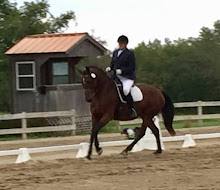Tuesday, October 22, 2013
Keeping the Dressage Horse's Energy Centered
We all know what a nicely moving dressage horse looks like moving nicely forward with a light contact on the reins. The light contact is the key. If there is no contact with the horse, it is really hard to have the horse hear any of your rein aids that tell him what is coming next. If there is too much contact and it feels like the horse is dragging you out of the saddle, you are not going to be able to communicate well either. There are also horses that alternate between no contact and heavy contact.
The first order of business in this situation is to have a steady outside rein for your horse to use as a guide. If the horse is able to pull your rein out of position or you as a rider accidently move it too much then the horse has no outside rein to guide him on the best place to be. I frequently place a leather strap or even twine string from one D ring to the other on the front of a dressage saddle so the rider can hold the outside rein and the strap at the same time. This teaches the rider who accidently moves their outside rein to keep it steady. This also helps the rider not be pulled forward if the horse is pulling on them.
One of the worst things you can do is see saw your reins. Becuase if your horse is heavy in the rein, he will either brace into the see saw or he will go completely light and have no contact with the bit. Neither of these options makes your horse easier to ride or more correct.
The energy of the horse should feel like it is centered under the saddle and the horse has his balance. To make this happen, there must be a light feel in the rein.
For the horse that is emptying the rein contact steadying the outside rein (even if you need to hold onto a strap with your outside hand) gives them a steady rein they can trust. Then gently push the horse forward into the contact. Some horses will go from no contact to heavy contact. That is o.k. if the contact gets heavy, flex the horse with your inside rein to encourage the horse to drop their head and neck and relax into the reins. The steady contact is really important as it will show the horse where to go. No contact means you need to push your horse forward to the bridle.
Then there are the horses which pull and are really hard to ride as they try to out muscle the rider. Oddly the same steady outside rein helps. The steady outside rein that holds the strap makes the outside rein secure. Then flex the horse's head and neck to the inside while you push him forward. Repeatedly reward forward and soft. This kind of horse uses bracing and blocking to make his job easier hoping his rider will give up. Instead the rider is going to push him actively into the bridle with a until he takes a softer contact and give this horse frequent breaks. If it is hard to get a softer contact, think mini lengthenings whenever you do not feel like you have enough effort. This horse gets physical breaks following a short period of nice forward work with a soft following neck and topline. In this way you can teach your bracing horse to go forward and soft.
Subscribe to:
Post Comments (Atom)

No comments:
Post a Comment
Note: Only a member of this blog may post a comment.